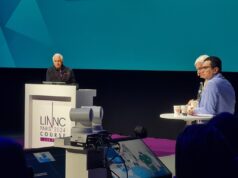
Earlier today, Sensome announced positive results from its first-in-human CLOT OUT clinical trial evaluating the safety and performance of the company’s Clotild smart guidewire system used during mechanical thrombectomy treatments for ischaemic stroke. The results showed that the technology met all primary safety and performance endpoints in the trial. There were no serious adverse events related to use of Clotild, and the device successfully automated the identification of red blood cells (RBCs) and platelets “in close alignment with human experts”, as noted in a Sensome press release.
The CLOT OUT study was presented on the final day of LINNC Paris 2024 (3–5 June, Paris, France) by principal investigator Aymeric Rouchaud (Limoges University Hospital, Limoges, France).
CLOT OUT is a single-arm, prospective, multicentre, first-in-human trial being conducted in France and Australia, encompassing 41 patients experiencing acute large-vessel ischaemic stroke in whom the Clotild guidewire was used before any thrombectomy pass. As a first-in-human study, the trial was intended to train the clot-sensing technology to further enhance Clotild’s in-situ clot characterisation performance.
The data presented today at LINNC Paris showed that, in a blinded-validation dataset, the Clotild technology’s predictive algorithms successfully identified RBCs and platelets—thereby demonstrating automated processing of thrombus signals acquired in situ by the sensor during the thrombectomy procedure. The technology demonstrated sensitivity of 95% (95% confidence interval [CI], 86–100%) and specificity of 93% (95% CI, 90–96%) for RBCs, and sensitivity of 87% (95% CI, 76–96%) and specificity of 94% (95% CI, 90–96%) for platelets, when compared to analyses by a human expert.
“Understanding the clot is critical to informing the approach we take to clot removal in life-saving stroke treatment, yet today’s imaging provides incomplete information,” Rouchaud said. “This results in 60% of thrombectomy cases requiring two or more passes to remove clot—with each pass reducing patient outcomes—and 10–20% of cases being unsuccessful in removing clot altogether. This first-in-human study showed that this smart guidewire safely navigated through the brain and successfully characterised common clot components without human analysis. This is an exciting development with the potential to give us a more complete picture of the clot that we are missing today in order to achieve better first-pass success.”
“In addition to the promise of improving our thrombectomy results, we appreciate that this technology integrated well with our current interventional workflow and didn’t require a new technique,” said Andrew Cheung (Liverpool Hospital, Liverpool, Australia), co-coordinating investigator of the CLOT OUT trial. “The Clotild device is ingenious—by simply replacing our existing guidewire with a smart wire, we may be able to gain better information that could help us significantly improve our patients’ chances of a full recovery after stroke.”
The Clotild clot-sensing guidewire integrates the world’s smallest electrical impedance sensor with machine learning, and is being developed to instantly identify clot composition and clot length in real-time, in order to inform treatment approaches during mechanical thrombectomy. Sensome believes it has the potential to be the first device to accurately identify clot length in fully occluded arteries in situ, as well as the first to characterise clots that remain in the body after failed removal attempts.
In two previous peer-reviewed publications, the company’s microsensor technology has been shown to reliably predict the RBC composition of retrieved clot with good sensitivity and specificity consistent with histologic findings. Data demonstrating the technology’s ability to do the same with platelets is pending publication, according to Sensome.
“Meeting all of the primary endpoints in our first-in-human study is an important milestone for our company and the first step in realising the full potential of our novel microsensor technology across several indications,” said Franz Bozsak, chief executive officer and co-founder of Sensome. “In this first use in stroke treatment, we showed that our technology was able to automate clot component identification with the accuracy of human experts. We look forward to further clinical study of Clotild in larger numbers of patients that will grow its capabilities to ultimately provide recommendations for a personalised treatment approach for each clot and patient.”
Sensome states that the Clotild smart guidewire system has been designated as a Breakthrough Device by the US Food and Drug Administration (FDA). It is currently considered an investigational device and is not approved for commercial use in the USA or any other jurisdiction.












